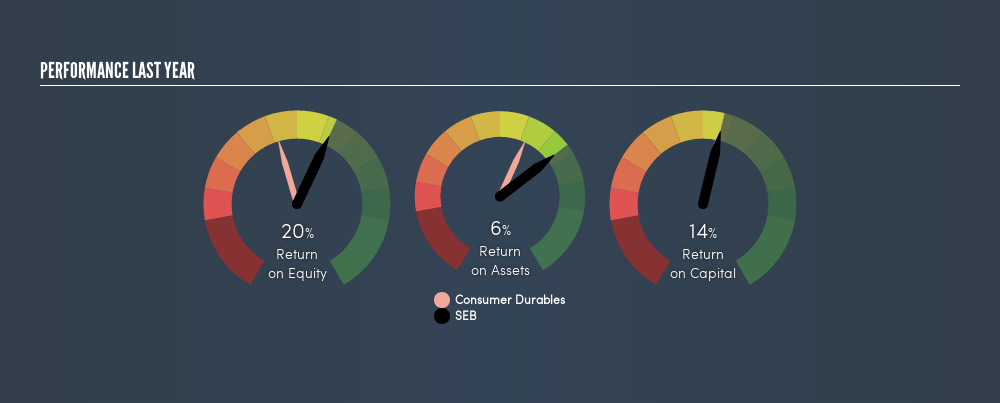
Want to participate in a short research study? Help shape the future of investing tools and you could win a $250 gift card!
Today we are going to look at SEB SA (EPA:SK) to see whether it might be an attractive investment prospect. Specifically, we're going to calculate its Return On Capital Employed (ROCE), in the hopes of getting some insight into the business.
First of all, we'll work out how to calculate ROCE. Second, we'll look at its ROCE compared to similar companies. Then we'll determine how its current liabilities are affecting its ROCE.
Understanding Return On Capital Employed (ROCE)
ROCE is a measure of a company's yearly pre-tax profit (its return), relative to the capital employed in the business. Generally speaking a higher ROCE is better. Overall, it is a valuable metric that has its flaws. Author Edwin Whiting says to be careful when comparing the ROCE of different businesses, since 'No two businesses are exactly alike.'
How Do You Calculate Return On Capital Employed?
The formula for calculating the return on capital employed is:
Return on Capital Employed = Earnings Before Interest and Tax (EBIT) ÷ (Total Assets - Current Liabilities)
Or for SEB:
0.14 = €652m ÷ (€7.1b - €2.3b) (Based on the trailing twelve months to December 2018.)
Therefore, SEB has an ROCE of 14%.
Check out our latest analysis for SEB
Does SEB Have A Good ROCE?
ROCE is commonly used for comparing the performance of similar businesses. It appears that SEB's ROCE is fairly close to the Consumer Durables industry average of 14%. Separate from SEB's performance relative to its industry, its ROCE in absolute terms looks satisfactory, and it may be worth researching in more depth.

Remember that this metric is backwards looking - it shows what has happened in the past, and does not accurately predict the future. Companies in cyclical industries can be difficult to understand using ROCE, as returns typically look high during boom times, and low during busts. ROCE is only a point-in-time measure. What happens in the future is pretty important for investors, so we have prepared a free report on analyst forecasts for SEB.
Do SEB's Current Liabilities Skew Its ROCE?
Current liabilities include invoices, such as supplier payments, short-term debt, or a tax bill, that need to be paid within 12 months. Due to the way the ROCE equation works, having large bills due in the near term can make it look as though a company has less capital employed, and thus a higher ROCE than usual. To check the impact of this, we calculate if a company has high current liabilities relative to its total assets.
SEB has total assets of €7.1b and current liabilities of €2.3b. Therefore its current liabilities are equivalent to approximately 32% of its total assets. SEB has a middling amount of current liabilities, increasing its ROCE somewhat.
What We Can Learn From SEB's ROCE
While its ROCE looks good, it's worth remembering that the current liabilities are making the business look better. SEB shapes up well under this analysis, but it is far from the only business delivering excellent numbers . You might also want to check this free collection of companies delivering excellent earnings growth.
If you like to buy stocks alongside management, then you might just love this free list of companies. (Hint: insiders have been buying them).
We aim to bring you long-term focused research analysis driven by fundamental data. Note that our analysis may not factor in the latest price-sensitive company announcements or qualitative material.
If you spot an error that warrants correction, please contact the editor at editorial-team@simplywallst.com. This article by Simply Wall St is general in nature. It does not constitute a recommendation to buy or sell any stock, and does not take account of your objectives, or your financial situation. Simply Wall St has no position in the stocks mentioned. Thank you for reading.
About ENXTPA:SK
SEB
Designs, manufactures, and markets small domestic equipment in Western Europe, rest of Europe, the Middle East, Africa, North and South America, China, and rest of Asia.
Good value with adequate balance sheet and pays a dividend.
Similar Companies
Market Insights
Community Narratives



